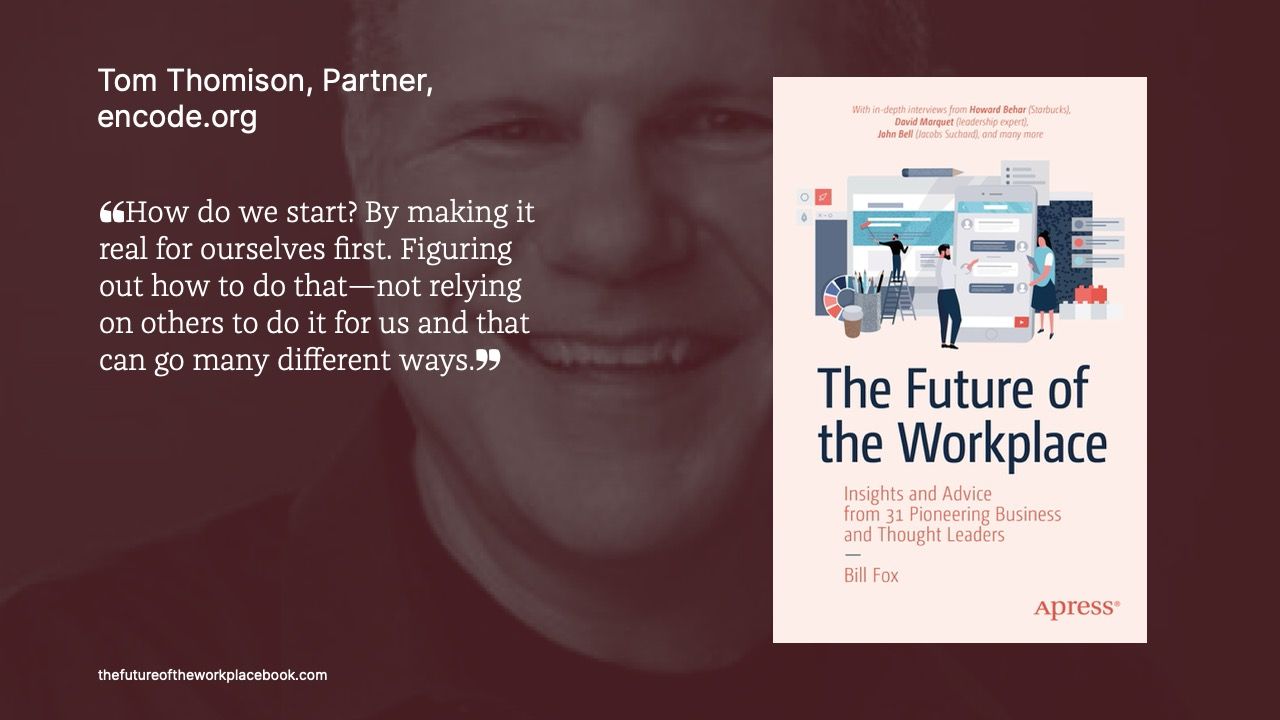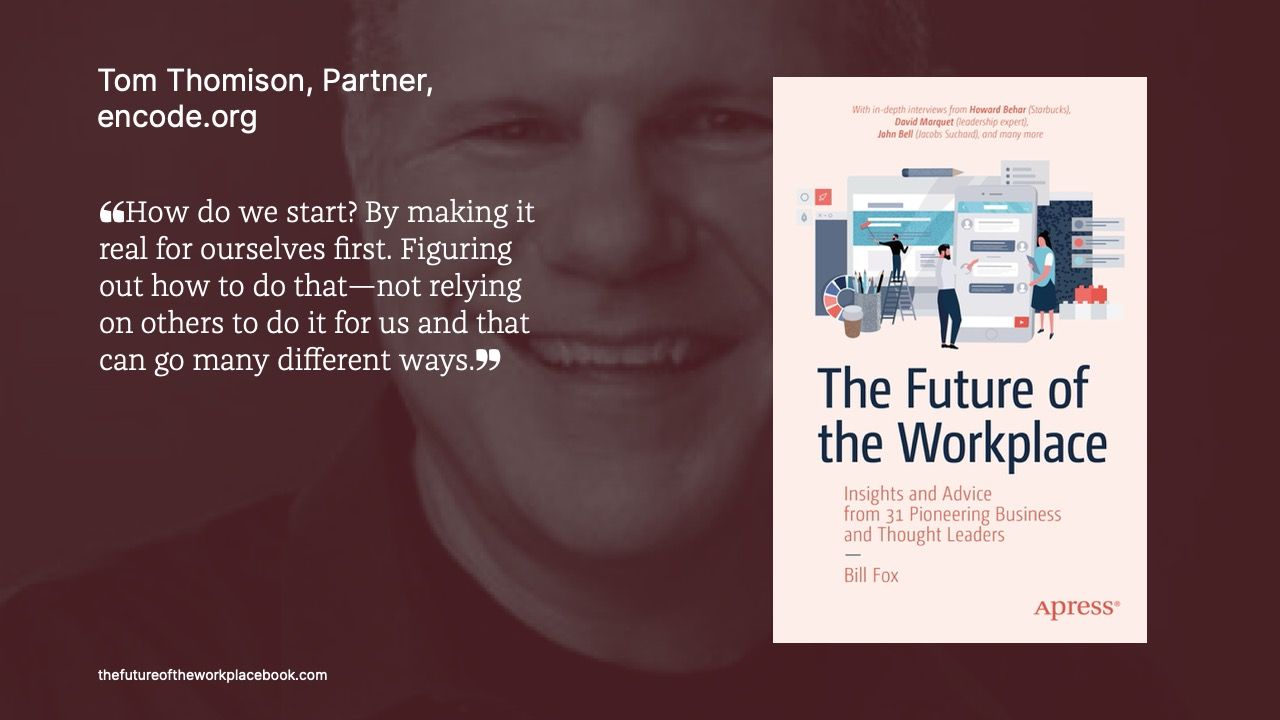How Do We Start and Make it Real?
Tom Thomison, partner at encode.org, helps us see why it's so important to address what's underneath and examine our core beliefs that have been around for a couple of hundred years.

Tom Thomison: Founding member and partner at encode.org llc and cofounder at HolacracyOne.
At Forward Thinking Workplaces, we are discovering the people, insights, and strategies that lead to Forward Thinking minds, leaders, and workplaces of the future — today. Forward Thinking narratives give you the perspective you need to succeed and will define the great workplaces of the 21st century. Check out our upcoming Events page or visit billfox.co to learn more.
How can we create a workplace where every voice matters, everyone thrives and finds meaning, and change and innovation happen naturally?
Tom Thomison: Those are very aspirational goals. I think we all want to work in that type of environment. I know I do.
How do we start? By making it real for ourselves first. Figuring out how to do that—not relying on others to do it for us and that can go many different ways.
If you’re an entrepreneur, you might start something. If you’re an innovator, you might find a company that wants to innovate with you. It’s taking accountability and responsibility and figuring it out for yourself.
Then from my perspective and my work over at least the last 20 years, it’s figuring out the answer to that question of how to make that real. For me, I tried, like most consultants and most business owners and entrepreneurs, with all the usual things—incremental improvements like business process reengineering, total quality management, higher-performance teaming, self-directed teaming, lean systems, agile systems, and agile development.
I was at the top of my consulting game about 10 to 15 years ago working with a lot of large enterprises and competing with all the big consulting firms like PWC, McKinsey, and others. Yet I was feeling like we’re beating our heads against the wall trying all these cool, clever techniques and not getting the results we wanted long term. It’s not that the techniques are bad. In fact, they have embedded in them kernels of brilliance, wisdom, and good practices. But what I found is they go back in the very same system that’s been around for a couple of hundred years—the authority system, the power hierarchy, the management hierarchy.
Inevitably over about 18 months, all that goodness that was in business process reengineering, or total quality management, or lean manufacturing atrophied, withered away and died.
So about 10 years ago, I got tired of beating my head against the wall. I was continuing to look for better ways to answer that question that you posed and that led me to all sorts of innovations. I crossed paths with Brian Robertson who was experimenting with the same question and with different approaches in his software company. What emerged from that was a company called HolacracyOne that we launched together in 2007 to change that management hierarchy, to change the power distribution system, to change the core fundamental operating system of an organization to make that kind of workspace that we want, and to bring into reality a place where you can show up—a place where you can lend your time, energy, and talent toward a purpose that you care about.
I think one of the fundamental ways of getting there is addressing and changing the core operating system, which gives a healthy environment for people to show up to innovate, participate, and have a sense of what might be possible for the organization—to do something about it. This environment would provide a pathway to do their work without the fear of being ignored or overruled and without the burden of trying to seek or reach consensus in ideas. Instead, they would have a self-organizing system, and this is at its roots what Holacracy is. It’s a self-management and self-organizing system to rethink the fundamental operating system or an organization completely.
For me, this is how I make that manifest. Starting a company 10 years ago to bring Holacracy into the world helps to address those issues. Another definition for it is a continuous improvement process. Holacracy is a self-organizing system that allows everyone to sense and respond to what’s needed—that is innovation. It’s continuous innovation because you’re continually sensing what might be possible, and you have a clear pathway to do something about it on an ongoing basis.
My story is like your story in the work you are doing here at Exploring Forward-Thinking Workplaces. It’s addressing what’s underneath. Sometimes the language we’ve been focused on is on the bolt-on ancillary systems, tools, and practices. But we haven’t addressed the core, which has been around a couple of hundred years or more—management hierarchy—top-down and predict and control. It’s hard to address the core, but I think it’s one of the most fundamental shifts that you can make to change the fundamental concept or understanding of what an organization is and change that core operating system.
What does it take to get an employee’s full attention and best performance?
Tom: First, don’t make them employees! [laughs] At my new endeavor, encode.org, we’re working to move beyond employees. With these new operating and self-management systems in place, we’re grounding those systems legally, so it allows for individuals to show up as full legal members wherever they are in their careers. This does not have the connotation that it’s big and heavyweight with lots of responsibility and capital investment. It just means a member that cares about the purpose of the organization can show up to sense and respond to whatever’s needed to participate in the running instruction of that organization and not be an employee.
I think your question is a perfectly valid question because 99.59% of the world is employer/employee relationships, but we need to change that.
I think embedded in the question is the problem. It’s the assumption that that’s how the world should be—an employer/employee relationship.
We need to change that. I’m working hard to make that a reality. It’s not just aspirational, but a concrete legal reality where we can take these very same self-organizing principles that we find in Holacracy and now embed those in our legal structures so that individuals who want to contribute to a purpose can do so as a legal partner, not as an employee.
Then we change the game completely because that person can now be an investor. Even if it’s just a little bit, the person can benefit from sharing in the profits of the organization and contribute toward the purpose they care about. They’re not following a leader; they’re not under a power hierarchy. They’re showing up consciously because they care about the work. And they contribute to that work through a self-managing or self-organizing process like Holacracy. This changes the game completely.
I have the opportunity to share this vision and the concrete reality we’re making with a lot of folks. People will often say to me, “What about the ordinary worker that just wants a paycheck?” I tell them that’s perfectly fine! In fact, even better! I’ve worked with a lot of organizations that would be classified as classic blue-collar kind of work. In those kinds of workers, there’s a passion for their craft, for their art, for their industry. They love what they do, and that is just fine. It doesn’t need to be any more than that.
An example I often use is an aviation company I work with. They are some cool folks that just love aviation. They love aircraft; they love the mechanics, the avionics, and the repair. They de-ice the planes, they refuel the planes, they maintain the planes—they love aviation. That was their craft. They can work as independent agents pursuing their purpose in an organization and just show up doing their work—participating and lending their time, energy, and talent to a purpose they care about in that format. Not as an employee, but as a legal partner. That’s how you get engagement.
Note: This is a preview of the full interview. The complete interview was selected by Apress for publication and continues in The Future of the Workplace.
